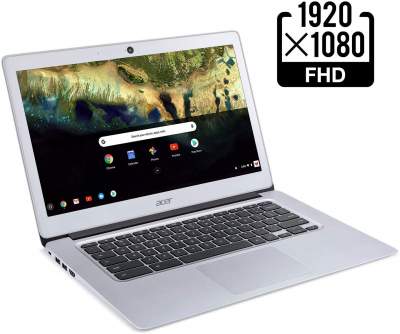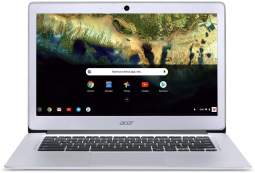ACER CHROMEBOOK 14 REVIEW
INTRODUCTION
In July of 2004, Google announced the Chrome OS project; an operating system that keeps both applications and user data in the cloud. By May 2011, the first Chrome OS Laptop was introduced to the market, with Samsung and Acer leading the charge. Acer has released some of the best Chromebook models till date but to be frank, before 2015, most of the Chromebooks available to the consumer were more or less cheap throw-aways. 2015 marked a departure from the norm with different manufacturers releasing better Chromebook models into the market.
Acer’s Chromebook 14 fits the above description perfectly; emerging as one sturdy laptop under 400 Dollars.
PROS & CONS
Acer’s Chromebook 14 is built out of aluminum, giving it a ‘premium’ air alien to old Chromebooks. The Chromebook 14 was designed to be appealing to the eyes and to a users’ sense of touch. A lot has been said and written about the aluminum body of the Chromebook 14 but in my opinion, the real achievement isn’t the type of material used for its body per se but the decency of the overall design. One other thing the Chromebook 14 has going for it is portability; the entire weight of the 14-inch laptop is 3.42 pounds.
I’m equally glad to announce to you that the Chromebook 14 has hinges that allow for the laptop lid to go all the way back; producing a totally flat configuration, meaning users of the Chromebook won’t have limitations with proper viewing. At the bottom of the computer, you’ll find a pair of speaker grilles, slightly raised because of the curviness of the laptop’s bottom. The way the Chromebook 14 is designed makes its speakers sound hollow, lacking much in bass output while remaining pretty loud. If you’re big on sound quality, you need to get headphones to enjoy the sound emanating from any media played on the Chromebook 14. One major deficiency of the Chromebook 14 that reviewers and users can’t stop highlighting is the laptop’s lack of an SD Card Slot for added storage. The absence of an SD Card Slot is a big nuisance because the Chromebook 14 only has 32 GB of Internal Storage. |  |
DESIGN
PORTS AND INTERCONNECTIVITY
The Chromebook 14, like most budget laptops, doesn’t have much in the way of ports; there are two USB 3.0 ports, an HDMI port and a headphone jack. One other noticeable hitch with the Chromebook 14 is the way the two USB ports are positioned next to each other, making it hard for users to connect 2 USB cables or SD Card Reader at the same time. The Chromebook 14 also has bluetooth 4.2 available for connectivity, with a 802.11ac WiFi Adapter to connect with wireless router in accessing the internet.
KEYBOARD
Quite a colony of Chromebook 14 users complain that the computer’s keys are a bit shallow for comfort as they don’t press deep enough for a soft feel. But some users fancy the keys for business meeting note-taking since the shallowness of the keys allows for silent typing. Meanwhile, the keyboard is also not backlit but that’s hardly a surprise for budget laptop users. People with large hands can comfortably type on the Chromebook 14 because the keys are well spaced.
TOUCHPAD
The Chromebook’s touchpad is large and responsive, with zero signs of jumpiness. It also supports multi-finger qualities while remaining fully clickable.
WEBCAM
The Chromebook 14 boasts of a HD Webcam (1280×720) with 88 degree wide angle lens supporting High Dispense Range (HDR). For what it’s worth, the webcam is not that great but it’s sufficient considering the Chromebook 14’s price point.
DISPLAY
On the whole, the Chromebook’s display is pleasant enough for day to day usage, going by the current standard of Chromebooks and Budget Laptops. The Chromebook 14 doesn’t have a touchscreen but it has full HD Resolution (1920x1080p). The Screen puts out vibrant colors with great viewing angles. The screen also has a matte finish and good glare handling but to be sure, the matte finish does mute the colors a little bit. The only pain point with the display is that one may not enjoy using the Chromebook 14 outside on a sunny day.
PERFORMANCE
The first thing a Chromebook 14 user is bound to notice is the boot speed. This is possible because it uses an Intel N3160 Quad Core Processor 1.6GHz with Intel Burst Technology up to 2.25 GHz paired with eMMC (solid state) storage instead of a hard drive. This is not in any way the most powerful processor out there but it’s adequate for most of the tasks traditionally carried out on Chromebooks. These tasks include but are not limited to text editing, book-keeping, internet-surfing, G-Suite, and show flicking. The Chromebook 14 is however not ideal for gaming (AAA Titles especially), photo-editing, video editing or any other task that makes heavy demands on the CPU.
Chromebooks lean heavily towards Google’s online suite of applications. People familiar with Microsoft apps can benefit from Microsoft apps on the Chromebook by installing these apps from the Google Play Store.
Chromebooks support Android Apps but owing to storage constraints, users won’t be able to download and install large applications on the Chromebook 14. The Chromebook 14 processor is lacking a cooling fan but that’s nothing to worry about as the processor doesn’t get hot during use.
RAM
The Chromebook 14 has a 4 GB LPDDR3 SDRAM Memory which is sufficient for everyday tasks like text editing, internet-surfing etc.
BATTERY LIFE
The Chromebook 14 has a 3 cell Li-polymer Battery (3950 mah) installed, giving it a good battery life expectancy. If used for surfing the internet and word processing, it can last 10-12 hours but streaming YouTube videos at full charge gives a user 8 hours of battery time. The Chromebook 14 is ideal for travelling since the battery can last for hours before a recharge.
HARD DISK
The Chromebook 14 has no hard disk or SSD but a 32 GB eMMC internal storage which is not upgradable. The eMMC storage type is generally used in tablets, mobile phones and budget laptops for its cost efficiency. In terms of performance, the eMMC storage type falls between the HDD and the SSD.
To make things easier for users, most eMMC equipped laptops come with a memory card slot that users can use to expand internal storage capacity. It’s surprising that the Acer Chromebook 14 has no such SD Card Slot.
SOFTWARE AND FEATURES
Setting up Linux on the Chromebook 14 is quite straightforward as users can leverage linux and android apps. Android apps can be accessed from the Google play store on Chromebooks. Note that some android apps weren’t designed to be responsive on big screens so you may have to hunt for their alternatives. After signing in to a Google account, Chromebook 14 users can use google docs for word processing and bookkeeping, knowing fully well that all their files are safely stored on the cloud.
WHAT’S MISSING?
As earlier noted, the obvious deficiency of Acer’s Chromebook 14 is the absence of an SD Card Slot for complementing the Chromebook’s paltry 32 GB eMMC internal storage capacity (non-upgradable). The only way to augment that deficiency is by plugging in a SD Card Reader into a USB Port. It’s worth mentioning that Chromebooks come with 100GB worth of free cloud storage for users. The Chromebook 14 is also missing a fingerprint sensor and by current standards, a Chromebook with a fingerprint sensor would have been a delightful surprise. Again, the Chromebook 14 isn’t a 2-in-1 laptop and that’s not unusual by current standards either.
BUY IT IF
The Chromebook 14 is ideal for people who only need a laptop for general use on a budget. People interested in special use need to look elsewhere for quality user experience. Consider buying Acer’s Chromebook 14 if you’re in the market for an aesthetically pleasing laptop that won’t require you participating in a bank heist.
DON’T BUY IT IF
Users with lofty expectations will find the Chromebook 14 anticlimactic, if not frustrating. If you’re a developer, photo editor, video editor, data analyst, ethical hacker or gamer, Chromebooks are not designed to handle your computational needs. For instance, the Chromebook 14’s internal storage capacity is too paltry to handle the kind of applications you’ll need for your tasks.
FINAL THOUGHTS
The Acer Chromebook 14 delivers a great experience for users who don’t have special computational needs at an affordable price point. For the most part, the Chromebook 14 meets all the needs of general users; it’s sturdy and aesthetically pleasing.

